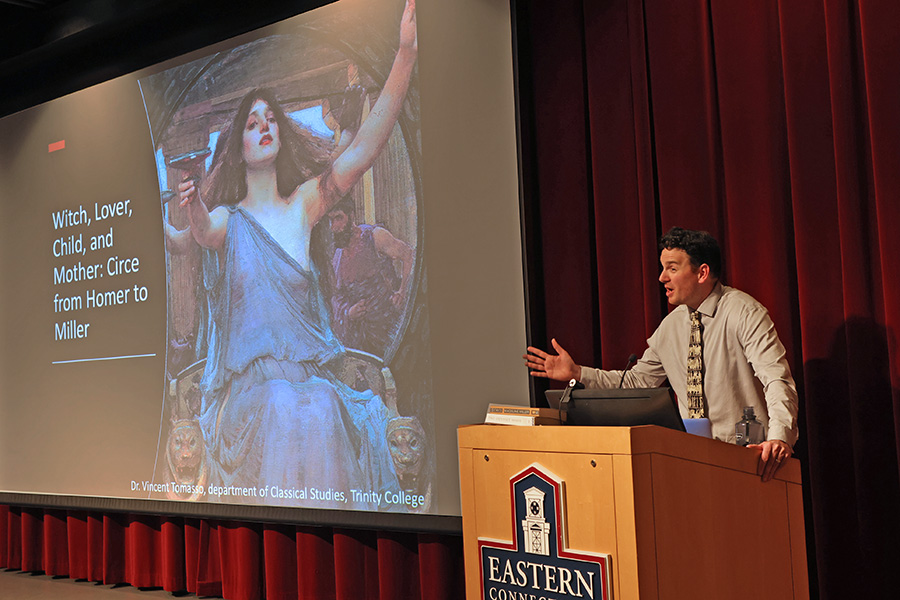- Apply
- Visit
- Request Info
- Give
‘Big Read’ begins with discussion on translation and adaptation
Written by Marcus Grant
Published on November 06, 2023

Eastern students and local community members came together on Oct. 26 for a discussion of Madeline Miller’s novel “Circe.” To kick off Eastern's Big Read program--of which "Circe" is the focus---Vincent Tomasso, a classics professor at Trinity College, presented a lecture titled “Witch, Lover, Child and Mother: Circe from Homer to Miller.”
The “Big Read” is a grant provided by the National Endowment of the Arts that “broadens our understanding of ourselves and our neighbors through the power of a shared reading experience.” It encourages community members to join students and professors in reading and discussing a book.
“We’re grateful for the opportunity to host another Big Read this year,” said Interim Associate Provost Benjamin Pauley Pauley. “It allows us, as a University, to bring people together.”
Tomasso's research explores ancient Greek poetry and the reception of antiquity by later cultures. Tomasso centered discussions on modern adaptations of "Circe" as a character and what it reveals about our current culture. As his guiding argument, Tomasso noted that, in Miller’s rendition, Circe acts as Odysseus did in Homer’s “The Odyssey.” It is for this reason, he said, that she is made into a three-dimensional character.
During the discussion, Tomasso used his knowledge of the ancient Greek language to translate for the audience. Homer’s Circe is a (translated) “terrible goddess,” he said, who enchants, beguiles or persuades those she turns into animals. Miller made her a self-identified witch, “reclaiming the term,” he said. Tomasso noted that the ancient Greeks would not have used the word “witch,” as it did not exist for them.
The audience responded well to these revelations with an abundance of questions as to why one translator may choose one word over another. An example he pointed out was that translator Emily Wilson used the phrase “far from the sea,” while Tomasso opted to use simply “from the sea.” Within these seemingly miniscule linguistic decisions, he reveals, is a different interpretation of the text.
English Professor Miriam Chirico said, “Not only is mythic revision an adaptation, but so is any translation.”
Tomasso also drew from interpretations of ancient readers of the epic poem. “It illuminates some aspects that give us more appreciation for the story,” Tomasso said. “It shows that the author and the audience were thinking about the issues present (in the poem).”
He also showed modern interpretations of Homer’s poem, pointing to the 1954 film “Ulysses” and an episode of “The Simpsons” from the early 2000s. Tomasso explained that these works “inform the background Miller was working in.” Both representations of Circe show her as a witch--with other influences contemporary with the years of their releases.
“Circe has played a variety of roles in retellings of her story since ‘The Odyssey,’” Speicher said. “I think how we respond to these roles depends very much on our own positionality and experiences, which is one reason it’s so important to bring diverse groups of readers together to discuss texts like this one.”
“Myths are remarkable in that they have a way of providing us with a significance and structure to our contemporary moment,” said Chirico, who had her students read the novel and encouraged them to participate in the discussion. She said that many students found the questions that Circe grappled with were similar to their own--especially the need to discover oneself.
“Students were especially drawn to revising myths about monstrous characters--like Medusa or Hades--to show how some scary figures had a back story that could explain how they might be misunderstood by others,” said Chirico.
Those in the audience saw this as well. Many said that Miller’s text resonated with women readers, as it elevated the voices of those who had not been given room to tell their stories in the past. Many highlighted the increase in retellings centered around female characters and their experiences.
“This is so important,” Tomasso said, “as these stories have purchase with us. We’ve heard them many times before--they're ingrained in our cultural consciousness.”
“Part of the joy of being one of the folks on campus giving away copies of the book is the sheer number of members of the campus community I’ve met by doing so,” said Speicher. “I also think these open conversations help to dispel a belief that might stop people from picking up a text like ‘Circe,’ the fear that they’re not a member of the target audience, that special expertise is needed to appreciate the novel’s allusions, or that as ‘untrained’ readers their perspectives aren’t valid and valuable.”
“I hope that participating in conversations like those hosted through the Big Read will help others claim their identities as readers,” said Speicher. “As a literature scholar, I believe that books belong to readers; I hope the discussions hosted through the Big Read will help folks within and beyond the Eastern community to proudly articulate the experiences, thoughts and feelings that reading brings into their lives, to speak their own truths, much as Miller imagines Circe speaking hers.”
“Big Read” events will continue for the remainder of the fall semester and into the spring semester. Sigma Tau Delta--the English honors society--Book Club and Creative Writing Club will host a virtual book discussion on Nov. 8 at 7 p.m. via Zoom. Interested parties can email Speicher for a link to the discussion.
Miller herself will host a virtual discussion of the book on April 17, where readers can ask questions about translations, literary choices and more. Free copies of “Circe” can be picked up from professors Allison Speicher in Webb Hall 253 and Julia Wintner in the FAIC Art Gallery.


